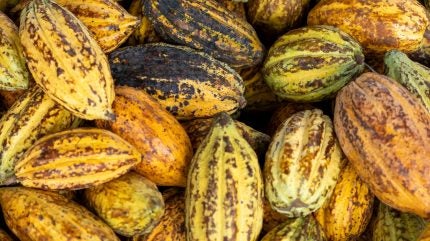[ad_1]

Cocoa farmers working under Nestlé’s income accelerator scheme have seen net income increase but the pay for many still doesn’t match living income, data shows.
According to a report from Dutch sustainable development group, the KIT Institute, in the past 18 months the total net income of participant households rose more than 38%.
The scheme is also said to have increased cocoa production by more than 32%.
Researchers assessed a sample of 2,000 households which have been taking part in the “test-at-scale” phase of Nestlé’s accelerator scheme across 28 cocoa cooperatives in the Côte d’Ivoire, West Africa since 2022.
Switzerland-based food giant Nestlé, behind chocolate brands such as KitKat, first launched a pilot income accelerator programme in Côte d’Ivoire in 2020, with the goal of closing the living income gap for cocoa farming households.
More than 10,000 families are being supported by the initiative in the region to date.
Access the most comprehensive Company Profiles
on the market, powered by GlobalData. Save hours of research. Gain competitive edge.

Company Profile – free
sample
Your download email will arrive shortly
We are confident about the
unique
quality of our Company Profiles. However, we want you to make the most
beneficial
decision for your business, so we offer a free sample that you can download by
submitting the below form
By GlobalData
According to the study, Nestlé’s programme has shrunk the living income gap in the region by $1,130.
They also found that the number of households earning a living income, which on average is $7,654 – went up from 10% to 20% in households who were part of the Nestlé scheme, versus from 10% to 13% in those that were not.
But despite the income boost, accelerator households’ total net income is still $2,780 short of the estimated living wage benchmark.
The report also stressed according to measures from the Poverty Probability Index, due to the rising cost-of-living, “The likelihood of falling below the national poverty line of Côte d’Ivoire, as measured by the Poverty Probability Index, has increased by around one percentage point in both the Accelerator and the comparison
groups,” it said.
As well as looking to close the living income gap in the cocoa industry, the scheme also plans to improve agricultural practices, “reduce child labour risk” and “promote gender equality”.
Since 2022, the programme is said to have brought on a 10 percentage point increase in school enrollment.
It has also led to a 36 percentage point increase in Côte d’Ivoire women being “classified as empowered”, according to the Women Empowerment Index measurements, as a result of increased access to financial services and income generating activities.
Nestlé’s cocoa income initiative is expected to be launched in Ghana this year, with a goal of reaching 30,000 families.
The Aero chocolate bar maker is looking to support 160,000 cocoa-farming families with the scheme by 2030.
Nestlé launched its first range of KitKat chocolate bars made using cocoa grown by farmers working in the accelerator initiative at the start of 2024.
In an update on the scheme issued today (30 April), Darrell High, global cocoa manager at Nestlé, said: “The test-at-scale of Nestlé’s income accelerator program has confirmed the initial results we saw in the pilot phase.
“The program is transforming the way cocoa is farmed by professionalising labour and ensuring trees are pruned. It is great to see that these professionally pruned farms deliver higher yields which translates to higher income for cocoa-farming families.
“By putting the family at the center of the program, we empower women who are supporting their children’s education and are pursuing opportunities to diversify their household’s income. We are continuing to gather feedback from the farming families, to learn and adapt the program accordingly. We are excited to have started to scale the program to 30 000 farming households and will continue to report on our progress.”
[ad_2]

